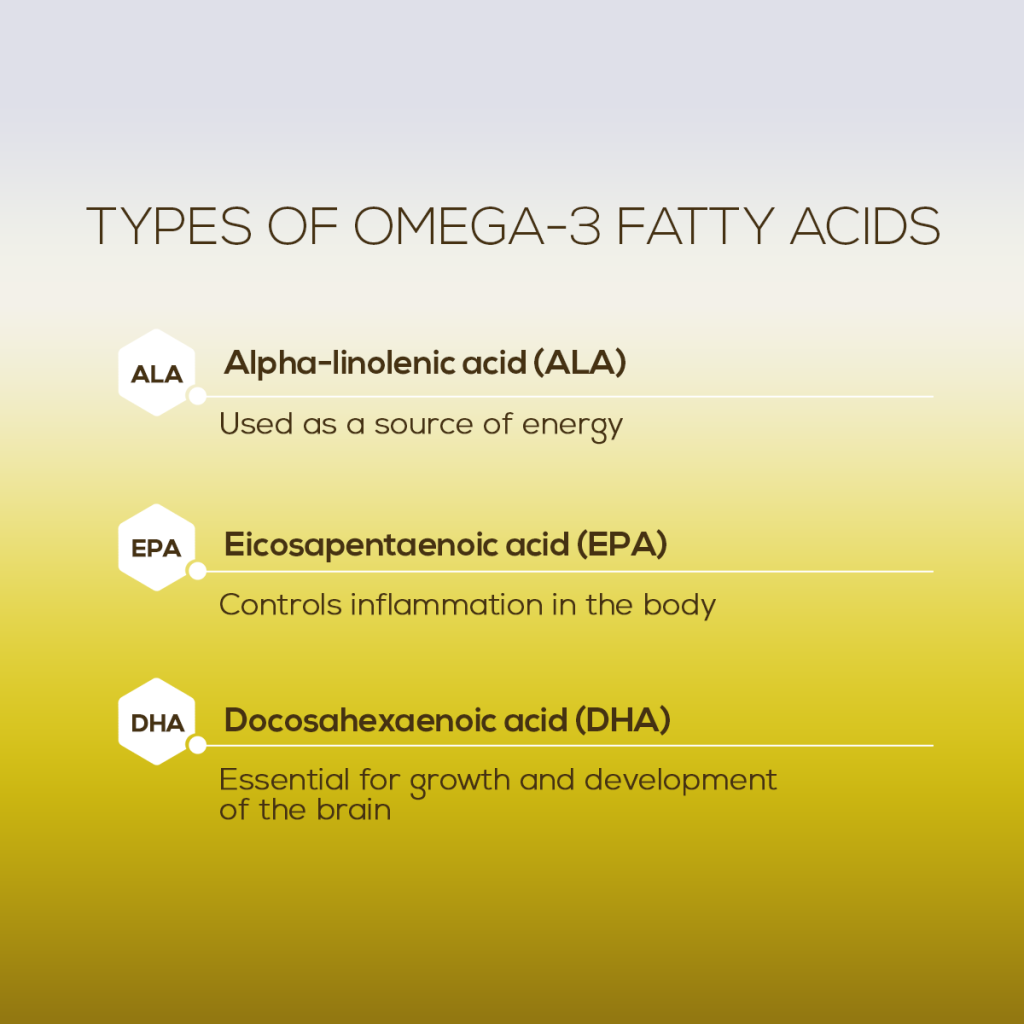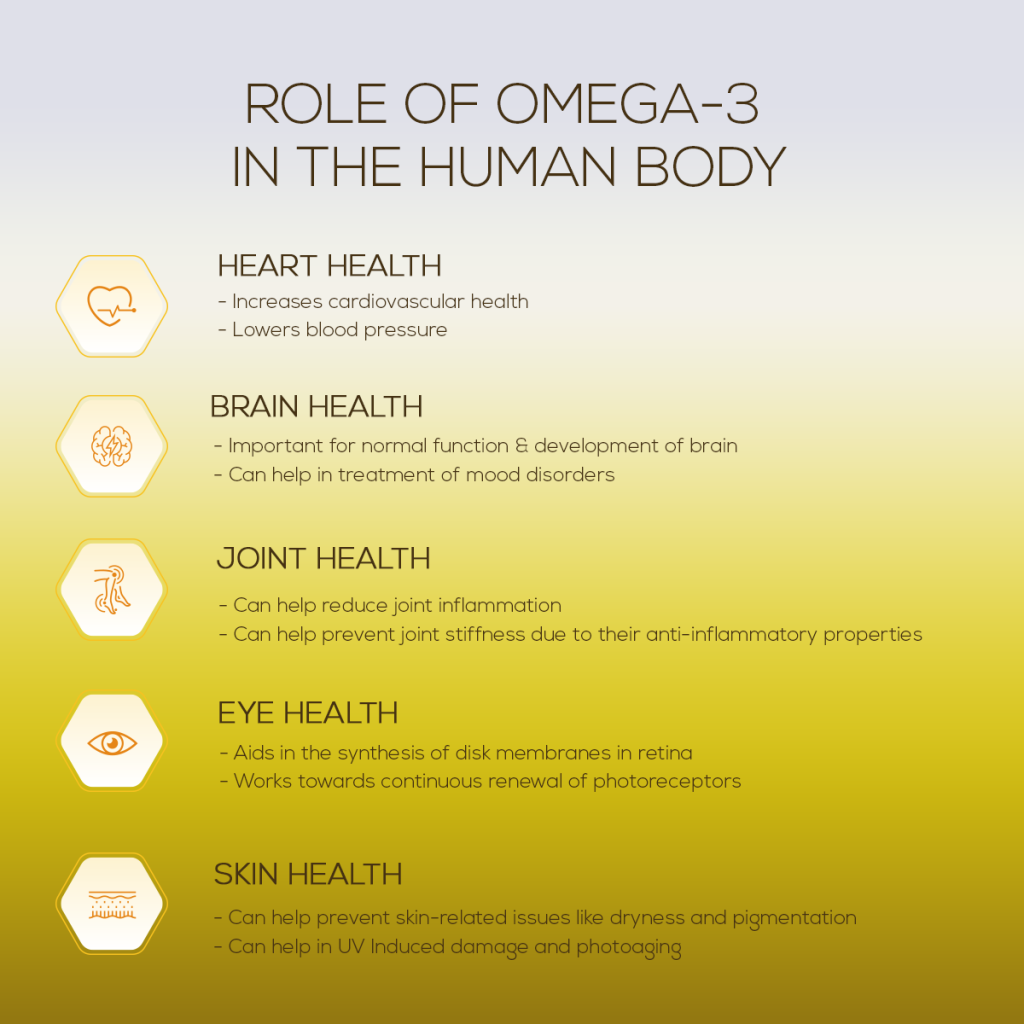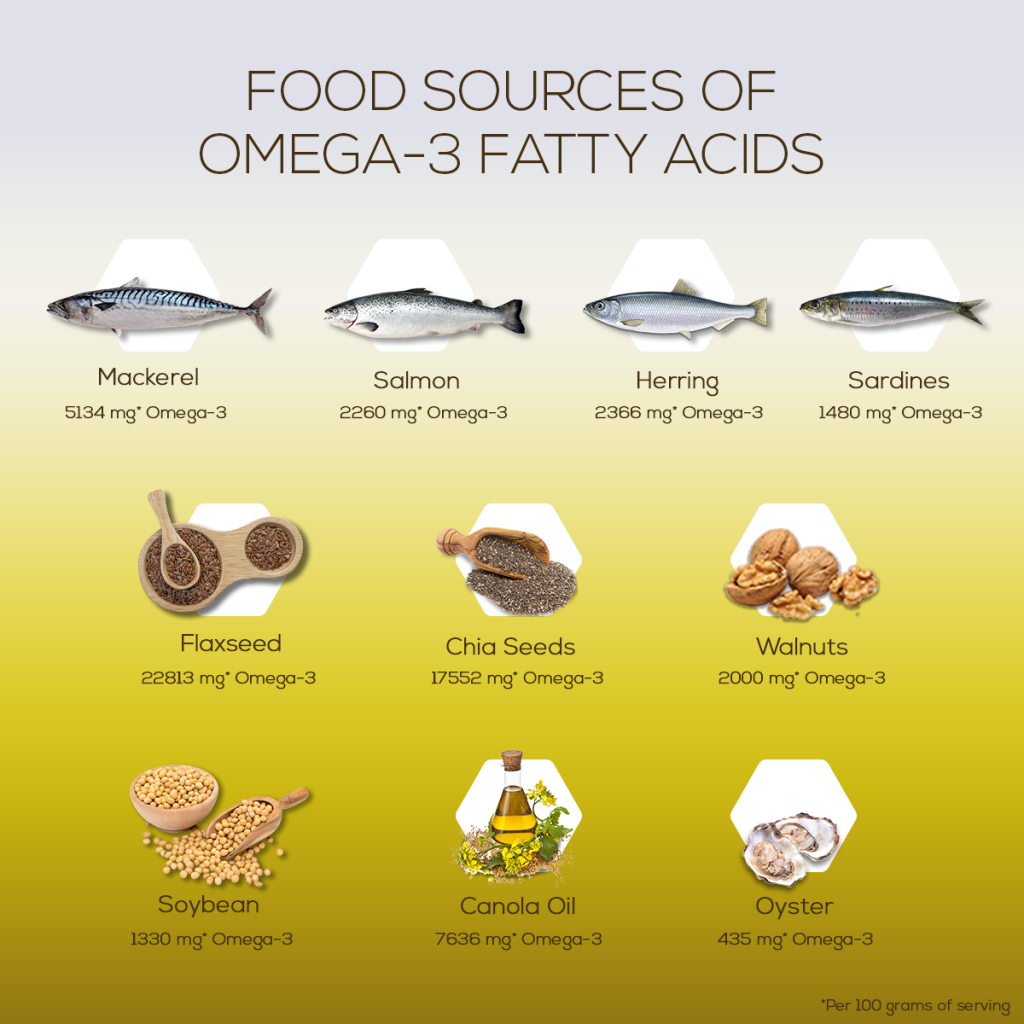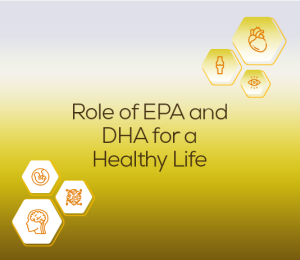Fats play an important role in the human body. From aiding energy production to tissue development, fats take care of it all. Fatty acids, the major components of body fat, are the long carbon chain molecules. Fatty acids play biological, structural and functional roles in the body.
Type of Fatty Acids
Fatty acids are divided as saturated and unsaturated fatty acids depending on the presence of double bonds between two carbon atoms. Saturated fatty acids molecules contain no double bonds while unsaturated fatty acids contain double bonds. This differentiation directly affects the functionality of different fatty acids [1].
Unsaturated fatty acids are further subdivided into Monounsaturated Fatty Acids (One C-C double bond in the chain) and Polyunsaturated Fatty Acids (more than one C-C double bond in the chain). There are three major dietary unsaturated fatty acids – Omega-3, Omega-6, and Omega-9. Omega-3 and Omega-6 are polyunsaturated fatty acids while Omega-9 is monounsaturated fatty acids.
What are Omega-3 Fatty Acids?
Omega-3 fatty acids are a family of essential Polyunsaturated Fatty Acids (PUFA). They are termed ‘essential’ because they’re are important for our health, but our body cannot produce these fats and therefore must consume it from external sources to meet the body’s requirement.
The ‘3’ in Omega-3 depicts the presence of the final double bond in the structure which is 3 carbon atoms away from the tail of the molecular chain. There are three major types of Omega -3 fatty acids:
- Alpha-linolenic acid (ALA)
Alpha-Linolenic acid (ALA), is the most easily accessible Omega-3 fatty acid and is commonly found in plant sources. ALA is mostly used as a source of energy. ALA are 18 carbon chain fatty acids.
Our body also converts some of the ALA to EPA and DHA. However, the process is not very efficient [2]. Our body can only convert up to 20% of ALA to EPA and only up to 9% of ALA is converted to DHA [3]. - Eicosapentaenoic acid (EPA)
EPA and DHA are a more functionally active form of Omega-3 and are prominently found in marine sources like mackerel, herring, tuna, halibut, salmon, cod liver, whale blubber, or seal blubber.
EPA is important for producing eicosanoids that help control inflammation in the body. Some studies have also shown that EPA can have beneficial effects on mood-related disorders [4]. - Docosahexaenoic acid (DHA)
DHA is important for our eye and brain health. It is the structural component of the human nervous system. The brain and eyes have significantly higher DHA levels as compared to other organs. DHA is especially concentrated in the grey matter of the brain and the retina. It is essential for the growth and development of the brain in infants as well as the maintenance of normal brain function in adults. DHA is also responsible for the quality of one’s vision [5].
Fatty fishes such as salmon, tuna, and mackerel are the primary sources of DHA.

Role of Omega-3
1. Heart Health
Omega-3 fatty acids have been tied to numerous benefits that promote a healthy heart. Omega-3 can help in reducing triglycerides levels, decreasing blood pressure, managing cholesterol levels and reduce inflammation. The heart health benefits of Omega-3 are –
- Antiarrhythmic effects
Omega-3 fatty acids stabilize the electrical activity of the heart muscle by inhibiting the ion channels [6]. - Antithrombotic activity
EPA has been shown to inhibit the synthesis of thromboxane A2, which causes platelet aggregation. Omega-3 helps in preventing blood platelets from clumping together and thus reducing the risk of blood clotting [7]. - Antiatherogenic effects
Omega-3 helps ensure that there is no plaque build-up in the arteries and keeps arteries smooth and free from damage [8]. - Lowering Blood Pressure
Omega-3 can help reduce blood pressure by preventing plaque build-up in the arteries and promoting smooth blood flow. - Maintain Cholesterol Levels
Omega-3 has been shown to continuous intake of Omega-3 can help increase HDL (Good Cholesterol) levels in the body. It can also reduce the total cholesterol levels by controlling the synthesis of LDL (Bad Cholesterol) and triglycerides in the body [9].
2. Brain Health
DHA from Omega-3 is the principal component of the brain and eyes. DHA is involved in maintaining the fundamental properties of cell membranes. DHA is important for normal function and development of the brain through all stages. DHA can influence a wide range of brain function alterations arising from cognitive disorders and brain aging. Omega- 3 can also help improve cognitive functions, neuron functions, and aid neurogenesis or brain cell regeneration.
Studies have also suggested that Omega-3 may have the potential for the treatment of multiple neurodegenerative and neurological disorders [10]. Intake of Omega-3 has been proven beneficial in the treatment of depression as well. The disorder characterized by sadness, loss of interest in activities, and decreased energy can be managed by replenishing the Omega-3 levels in the body [11].
3. Joint Health
Joint health is a point of major concern for India. According to a study, Osteoarthritis is the second most common rheumatologic problem in India [12]. The most common symptom of joint related problems is knee pain followed by pain in the shoulders, fingers, and hips. Typically, the culprit behind chronic joint pain is arthritis, a debilitating inflammatory condition of the joints [13]. Omega-3, owing to its anti-inflammatory properties, can help reduce joint inflammation.
Omega-3 inhibits the production of inflammatory cytokines responsible for the pain caused by arthritis. Studies have also shown that the intake of EPA and DHA supplementation has been effective against arthritic pain as well as its other symptoms such as joint stiffness due to their anti-inflammatory properties [14].
4. Eye Health
Eye health and Omega-3 fatty acids have a strong, positive correlation. The brain and eye are highly enriched with Omega-3. DHA is present in large amounts in the retina, specifically in the disk membranes of the outer segments of photoreceptor cells.
According to studies, increasing omega-3 PUFA tissue levels by dietary intake increases vessel regrowth after injury, and reducing the hypoxic stimulus. It also aids in the synthesis of disk membranes, promotes conformational rhodopsin changes, it also works towards the continuous renewal of photoreceptors, and in modifying the activity of retinal enzymes [15].
5. Skin Health
Our skin is under constant attack caused by internal oxidative damage as well as external oxidative damage in the form of pollution, exposure to UV rays, etc. Omega-3 plays an essential role in skin protection and prevention of skin related issues such as photoaging, and dermatitis [16].
Photoaging is aging of the human skin due to the damage caused by the ultraviolet rays. This damage can include sunburn, photosensitivity, and inflammation. Studies revealed that Omega-3 can combat damage caused by the ultraviolet rays.
Dermatitis is a skin condition that often causes inflammation, thickened plaques and marred itchy skin. These symptoms of dermatitis can cause barrier function defects, followed by the invasion of bacteria and allergens, as well as dry skin. Studies have revealed that usage of Omega-3 rich fish oils can help relieve the skin of such symptoms and replenishing the skin hydration by up to 30%.
6. Anti-Inflammatory Properties
Omega-3 has anti-inflammatory properties. It decreases the production of inflammatory eicosanoids and cytokines. Omega-3 directly controls inflammation by replacing the base component of inflammatory arachidonic acid and therefore the inflammatory substance production. It also inhibits the gene signaling for inflammatory action thereby controlling inflammation indirectly [17].

Omega-3 Food Sources
There is no recommended dietary limit for Omega-3. However, experts recommend 1000 – 2000 mg of Omega-3 per day to meet the body’s daily requirement. Here are a few food sources rich in Omega-3 fatty acids (values per 100 g):
- Mackerel – 5134 mg Omega-3
- Salmon – 2260 mg Omega-3
- Herring – 2366 mg Omega-3
- Sardines – 1480 mg Omega-3
- Flaxseed – 22813 mg Omega-3, 5911 mg Omega-6
- Chia Seeds – 17552 mg Omega-3, 5785 Omega-6
- Walnuts – 2000 mg Omega-3, 33000 Omega-6
- Soybean – 1330 mg Omega-3, 9920 Omega-6
- Canola Oil – 7636 mg Omega-3, 18759 mg Omega-6
- Caviar – 6790 mg Omega-3
- Oyster – 435 mg Omega-3

Omega-3 Supplements: Do we need them?
Indian Council of Medical Research has stressed on increasing the intake of Omega-3 over the years, keeping in mind the key roles they play in the human body. However, it can be difficult to maintain optimum levels of Omega- 3 fatty acids in the body through diet alone: especially keeping in mind the Indian dietary patterns [18]. Consuming fishes on a daily basis is a little difficult for most Indians. Also, vegans are more at risk of missing out on the adequate intake of EPA/DHA because plant sources contain only ALA. The recurring issue with consuming Omega-3 rich sources regularly makes intake of Omega-3 supplement necessary.
Things to Keep in Mind While Selecting Omega-3 Supplements
Indian market is flooded with multiple Omega-3 supplements, making the decision of choosing the right Omega-3 supplement a tedious process. Following are the key things that should be kept in mind while selecting the right Omega- supplement
- Type of Omega-3
The three major Omega -3 fatty acids have different benefits. Different supplements vary in their ALA, DHA, and EPA content. EPA and DHA are the functionally active fatty acids. Therefore, make sure the selected supplement has an adequate amount of EPA/DHA in them. - Amount of Omega-3
Read the product label carefully to discern the actual EPA/DHA content in the supplement. Omega-3 is a family of fatty acids and therefore a product with 1000 mg of fish oil per capsule is likely to have less than 1000 mg of EPA/DHA Content. Check the actual EPA/DHA content on the product label before making a purchase. - Form of Omega-3
Check for Omega-3 form in the supplement. Omega-3 Fish oil might be in the form of triglycerides, reformed triglycerides, ethyl esters, and phospholipids. Fish oil containing triglycerides is generally better absorbed by the body. - Purity and Authenticity
Always make sure that your Omega-3 supplements have gone through stringent safety and purity checks. The fish oil supplement should be free from heavy metals and contain high purity fish oil. - Fish Oil Source
Omega-3 fish oil supplements have multiple fish oil sources in existence. Natural fish oil (sardines, salmon, herring, cod liver), processed fish oil, Krill Oil, Mammalian oil, ALA oil, Algal oil are some of the fish oil sources. Choose the fish oil source as per personal dietary preference and the requirement. - Presence of Allergens
People with seafood allergies need to carefully go through the literature that comes along with the supplement to make sure that it does not contain any ingredient that might trigger the allergies.
Possible Side Effects
Intake of authentic omega-3 supplements is usually safe for consumption with little side effects. However, in some cases, supplements can cause certain mild side effects. These may include [19]:
- Unpleasant Aftertaste
- Bad Breath
- Bad Smelling Sweat
- Headache
- Heartburn
- Nausea
In Conclusion…
Omega-3 fatty acids play a significant role in the overall health of the human body. They play important roles in brain development, eye development, maintaining a healthy heart, our joints moving and protecting our skin. The daily requirement of Omega-3 can be fulfilled by easily accessible food sources. Omega-3 supplements can be also considered to meet the daily requirement of Omega-3 in the body.
Sources:
[1] https://www.ncbi.nlm.nih.gov/pubmed/25471798
[2] https://www.ncbi.nlm.nih.gov/pubmed/16828546
[3] https://www.ncbi.nlm.nih.gov/pubmed/12323090
[4] https://www.ncbi.nlm.nih.gov/pmc/articles/PMC4404917/
[5] https://www.ncbi.nlm.nih.gov/pmc/articles/PMC4728620/
[6] Leaf A. The electrophysiologic basis for the antiarrhythmic actions of polyunsaturated fatty acids. Eur Heart J. 2001; 22: D98–D105
[7] https://www.ncbi.nlm.nih.gov/pubmed/11997274
[8] https://www.ncbi.nlm.nih.gov/pubmed/22317966
[9] https://www.ncbi.nlm.nih.gov/pmc/articles/PMC1780156/
[10] https://www.ncbi.nlm.nih.gov/pmc/articles/PMC4404917/
[11] https://www.ncbi.nlm.nih.gov/pmc/articles/PMC3976923/
[12] https://www.ncbi.nlm.nih.gov/pmc/articles/PMC5017174/
[13] https://www.ncbi.nlm.nih.gov/pmc/articles/PMC4712866/
[14] https://www.ncbi.nlm.nih.gov/pubmed/17335973/
[15] https://www.ncbi.nlm.nih.gov/pmc/articles/PMC3206354/
[16] https://www.ncbi.nlm.nih.gov/pmc/articles/PMC6117694/
[17] https://academic.oup.com/ajcn/article/83/6/1505S/4633275
[18] https://www.ncbi.nlm.nih.gov/pmc/articles/PMC5345296/
[19] https://nccih.nih.gov/health/omega3/introduction.htm










